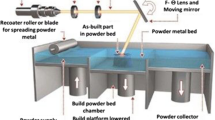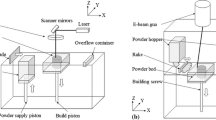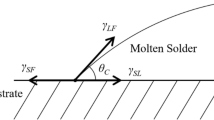Abstract
Wire + arc additive manufacturing is an arc welding process that uses non-consumable tungsten electrodes to produce the weld. The material used in this study is a titanium, carbon, zirconium, and molybdenum alloy that is physically and chemically stable and has good performance for use as a welding and high-temperature heating element. In this study, welding experiments are designed based on a central composite design, and single-layer wire + arc additive manufacturing is performed using the titanium, carbon, zirconium, and molybdenum alloy. Consequently, 17 beads are obtained and the height, width, left and right toe angles, which represent the geometry of the beads are measured. Based on the measured geometry, response surface models for mean and standard deviation of the four geometries are fitted. Mean absolute percentage error of the four response surface models is 16.6% on average which implies that the models are reasonably well fitted. Based on the response surface models, the optimal settings for the Wire + arc additive manufacturing parameters are obtained by using a desirability function method. At the optimal setting, the desirability function value shows 0.85 on average which is close to ideal value of 1.00. This result indicates that valid optimal settings for the process parameters can be obtained via the proposed method.









Similar content being viewed by others
References
Wu B, Pan Z, Ding D, Cuiuri D, Li H, Xu J, Norrish J (2008) A review of the wire arc additive manufacturing of metals: properties, defects and quality improvement. J Manuf Process 35:127–139. https://doi.org/10.1016/j.jmapro.2018.08.001
Danisman CB, Yavas B, Yucel O, Sahin F, Goller G (2016) Processing and characterization of spark plasma sintered TZM alloy. J Alloys Compd 685:860–868. https://doi.org/10.1016/j.jallcom.2016.06.161
Yu B, Wang T, Lv Y, Jiang S, Yang J, Feng J (2021) Interfacial strengthening mechanism of electron beam welding-brazed TZM/30CrMnSiA joint with a vanadium interlayer. Mater Sci Eng, A 817:141369. https://doi.org/10.1016/j.msea.2021.141369
Moskal G, Grabowski A, Lisiecki A (2015) Laser remelting of silicide coatings on Mo and TZM alloy. Solid State Phenom 226:121–126. https://doi.org/10.4028/www.scientific.net/SSP.226.121
Chakraborty SP, Krishnamurthy N (2014) Fabrication of a Mo based high temperature TZM alloy by non-consumable arc melting technique. Proc Int Symp Disch Electr Insul Vac ISDEIV 749–752. https://doi.org/10.1109/DEIV.2014.6961791
Sharma IG, Chakraborty SP, Suri AK (2005) Preparation of TZM alloy by aluminothermic smelting and its characterization. J Alloys Compd 393:122–127. https://doi.org/10.1016/j.jallcom.2004.09.055
Ghazali MAM, Harimon MA, Mustapa MS (2020) Mechanical behavior and microstructural analysis of Molybdenum-TZM alloy subjected to different annealing temperature. JSE J Sci Eng 1:25–29. https://doi.org/10.30650/jse.v1i1.522
Fan J, Lu M, Cheng H, Tian J, Huang B (2009) Effect of alloying elements Ti, Zr on the property and microstructure of molybdenum. Int J Refract Met Hard Mater 27:78–82. https://doi.org/10.1016/j.ijrmhm.2008.03.006
Kaserer L et al (2020) Microstructure and mechanical properties of molybdenum-titanium-zirconium-carbon alloy TZM processed via laser powder-bed fusion. Int J Refract Met Hard Mater. https://doi.org/10.1016/j.ijrmhm.2020.105369
Myers RH, Montgomery DC, Anderson-Cook CM (2016) Response surface methodology: process and product optimization using designed experiments. John Wiley & Sons
Kim D, Rhee S, Park H (2002) Modelling and optimization of a GMA welding process by genetic algorithm and response surface methodology. Int J Prod Res 40:1699–1711. https://doi.org/10.1080/00207540110119964
Dey V, Pratihar DK, Datta GL, Jha MN, Saha TK, Bapat AV (2009) Optimization of bead geometry in electron beam welding using a genetic algorithm. J Mater Process Technol 209:1151–1157. https://doi.org/10.1016/j.jmatprotec.2008.03.019
Geng H, Li J, Xiong J, Lin X, Zhang F (2017) Optimization of wire feed for WAAM based additive manufacturing. J Mater Process Technol 243:40–47. https://doi.org/10.1016/j.jmatprotec.2016.11.027
Benyounis KY, Olabi AG, Hashmi MSJ (2005) Effect of laser welding parameters on the heat input and weld-bead profile. J Mater Process Technol 164:978–985. https://doi.org/10.1016/j.jmatprotec.2005.02.060
Gunaraj V, Muruga N (1999) Application of response surface methodology for predicting weld bead quality in submerged arc welding of pipes. J Mater Process Technol 88:266–275. https://doi.org/10.1016/S0924-0136(98)00405-1
Lee DH, Kim SH, Byun JH (2020) A method of steepest ascent for multiresponse surface optimization using a desirability function method. Qual Reliab Eng Int 36:1931–1948. https://doi.org/10.1002/qre.2666
Lee DH, Jeong IJ, Kim KJ (2018) A desirability function method for optimizing mean and variability of multiple responses using a posterior preference articulation approach. Qual Reliab Eng Int 34:360–376. https://doi.org/10.1002/qre.2258
Derringer G, Suich R (1980) Simultaneous optimization of several response variables. J Qual Technol 12:214–219. https://doi.org/10.1080/00224065.1980.11980968
Lunani M, Nair VN, Wasserman GS (1997) Graphical methods for robust design with dynamic characteristics. J Qual Technol 29:327–338
Vining GG, Myers RH (1990) Combining Taguchi and response surface philosophies: a dual response approach. J Qual Technol 22:38–45
Lin DK, Tu W (1995) Dual response surface optimization. J Qual Technol 27:34–39
Kim KJ, Lin DK (1998) Dual response surface optimization: a fuzzy modeling approach. J Qual Technol 30:1–10
Copeland KA, Nelson PR (1996) Dual response optimization via direct function minimization. J Qual Technol 28:331–336
Lee DH, Jeong IJ, Kim KJ (2009) A posterior preference articulation approach to dual-response-surface optimization. IIE Trans 42:161–171
Ames A, Mattucci N, McDonald S, Szonyi G, Hawkins D (1997) Quality loss function for optimization across multiple response surfaces. J Qual Technol 29:339–346
Pignatiello J (1993) Strategies for robustmultiresponse quality engineering. IIE Trans 25:5–15
Vining G (1998) A compromise approach to multiresponse optimization. J Qual Technol 30:309–313
Ko Y, Kim K, Jun C (2005) A new loss function-basedmethod for multiresponse optimization. J Qual Technol 37:50–59
Lee D, Kim K, Köksalan M (2012) An interactive method to multiresponse surface optimization based on pairwise comparisons. IIE Trans 44:13–26
Xu D, Albin SL (2003) Robust optimization of experimentally derived objective functions. IIE Trans 35:793–802. https://doi.org/10.1080/07408170304408
Ji C, Lu X, Zhang W (2020) A biobjective optimization model for expert opinions aggregation and its application in group decision making. IEEE Syst J 15:2834–2844
Cai M, Lin Y, Han B, Liu C, Zhang W (2016) On a simple and efficient approach to probability distribution function aggregation. IEEE Trans Syst Man Cybern Syst 47:2444–2453
Funding
This research was supported by the MSIT (Ministry of Science, ICT), Korea, under the High-Potential Individuals Global Training Program) (No. 2020–0-01539) supervised by the IITP (Institute for Information & Communications Technology Planning & Evaluation).
Author information
Authors and Affiliations
Corresponding author
Ethics declarations
Ethics approval
The submitted work is original, complete, and has not been submitted/published elsewhere in any form or language.
Consent to participate
Not applicable.
Consent for publication
The authors provide their consent to publish the manuscript in the International Journal of Advanced Manufacturing Technology.
Competing interests
The authors declare no competing interests.
Additional information
Publisher's note
Springer Nature remains neutral with regard to jurisdictional claims in published maps and institutional affiliations.
Highlights
• Massive measurement data for the TZM bead geometry were collected using a coordinate measuring machine.
• The mean and variance of the TZM bead geometry were modeled as second-order models using response surface methodologies.
• The optimal settings for the wire + arc additive manufacturing process parameters were obtained via a desirability function method.
Rights and permissions
About this article
Cite this article
Cho, JS., Lee, DH., Seo, GJ. et al. Optimizing the mean and variance of bead geometry in the wire + arc additive manufacturing using a desirability function method. Int J Adv Manuf Technol 120, 7771–7783 (2022). https://doi.org/10.1007/s00170-022-09237-6
Received:
Accepted:
Published:
Issue Date:
DOI: https://doi.org/10.1007/s00170-022-09237-6




